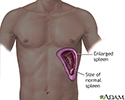Splenomegaly
Spleen enlargement; Enlarged spleen; Spleen swelling
Splenomegaly is a larger-than-normal spleen. The spleen is an organ in the upper left part of the belly.
Considerations
The spleen is an organ that is a part of the lymph system. The spleen filters the blood and maintains healthy red and white blood cells and platelets. It also plays a role in immune function.
Many health conditions can affect the spleen. These include:
- Diseases of the blood or lymph system
- Infections
- Cancer
- Liver disease
Symptoms of splenomegaly include:
- Hiccups
- Inability to eat a large meal
- Pain in the upper left side of the belly
Causes
Splenomegaly can be caused by any of the following:
- Infections
- Liver diseases
- Blood diseases
- Cancer
Home Care
In rare cases, an injury can rupture the spleen. If you have splenomegaly, your health care provider may advise you to avoid contact sports. Your provider will tell you what else you need to do to take care of yourself and any medical condition.
When to Contact a Medical Professional
There are usually no symptoms from an enlarged spleen. Seek medical help right away if pain in your belly is severe or gets worse when you take a deep breath.
What to Expect at Your Office Visit
Your provider will ask about your symptoms and medical history.
A physical exam will be done. Your provider will feel and tap along the upper left part of your belly, especially just under the rib cage.
Tests that may be done include:
- Abdominal x-ray, ultrasound, or CT scan
- Blood tests, such as a complete blood count (CBC) and tests of your liver function
The treatment depends on the cause of splenomegaly.
References
Wall DJ. The spleen. In: Rumack CM, Levine D, eds. Diagnostic Ultrasound. 6th ed. Philadelphia, PA: Elsevier; 2024:chap 5.
Winter JN. Approach to the patient with lymphadenopathy or splenomegaly. In: Goldman L, Cooney KA, eds. Goldman-Cecil Medicine. 27th ed. Philadelphia, PA: Elsevier; 2024:chap 154.
Wood VH, Cooperberg PL, Vos PM. Benign and malignant lesions of the spleen. In: Gore RM, ed. Textbook of Gastrointestinal Radiology. 5th ed. Philadelphia, PA: Elsevier; 2021:chap 62.
Review Date: 3/31/2024
Reviewed By: Todd Gersten, MD, Hematology/Oncology, Florida Cancer Specialists & Research Institute, Wellington, FL. Review provided by VeriMed Healthcare Network. Also reviewed by David C. Dugdale, MD, Medical Director, Brenda Conaway, Editorial Director, and the A.D.A.M. Editorial team.









